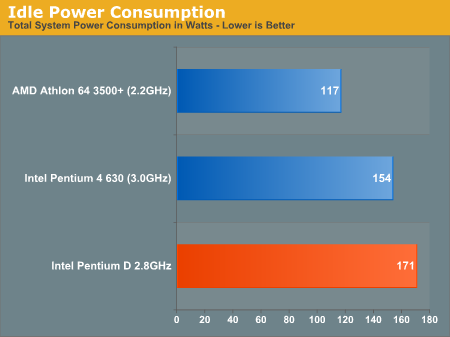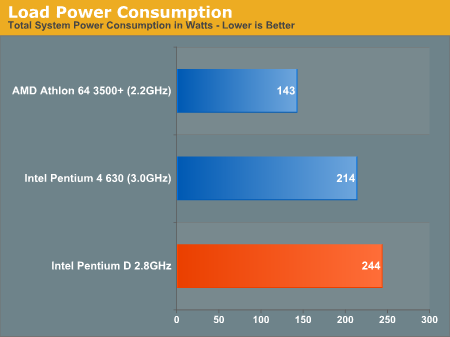Intel Dual Core Performance Preview Part II: A Deeper Look
by Anand Lal Shimpi on April 6, 2005 12:23 PM EST- Posted in
- CPUs
I'll admit, dual core has me excited for many of the reasons outlined in Part I. A big part is that personally, I've been using multiprocessor systems in my main computer for years. I've always appreciated the benefits of multiprocessor platforms, but recommending one for a desktop user has never been really feasible. Even the cheapest 2P workstation motherboards were at least twice the price of a desktop motherboard, not to mention the cost of the CPUs. The mass market had a short affair with multiprocessing in the days of the ABIT BP6 and the Celeron 300A, but in the grand scheme of things, that was barely a blip on the radar. Now, for the first time, both AMD and Intel are ready to bring the type of robustness of multiprocessor platforms to the desktop with their dual core offerings.
Part I focused on what dual core can offer, but now it's time for a much more practical look. We've never recommended Intel's Extreme Edition line of processors nor AMD's FX series, both supposedly marketed to gamers, but not purchased by any of our gaming readers. The processors that we recommend are usually much better values for the price, and thus, today's comparison isn't based around the most expensive dual core offerings, but rather the cheapest.
A point we made in the first article was that Intel's pricing strategy for dual core is extremely aggressive, with the cheapest 2.8GHz Pentium D soon to be introduced at $241. The problem is that at only 2.8GHz, the Pentium D won't have the strongest single threaded performance, which puts buyers in a sticky situation - do you buy an Athlon 64 3500+ for great single threaded performance or will the Pentium D give you a better overall multitasking experience? Intel doesn't do much to complicate the situation, as the Pentium D 2.8GHz will be close in price to the Pentium 4 630 (3.0GHz), which isn't much of a clock speed advantage. AMD will eventually have competitively priced dual core parts, but right now, AMD doesn't appear to be looking at the mainstream desktop market for dual core Athlon 64 chips.
The three chips mentioned above are the basis of the majority of today's comparison, but the decision is far from clear cut. Let's find out why.
Power Consumption
We'll start with power consumption - the contenders? A 90nm Athlon 64 3500+ vs. the Pentium 4 630 and the dual core 2.8GHz Pentium D. As always, we measured total system power at two states: idle and under a full load. For our full load test, we used a multithreaded application, 3ds max 7, performing the CBALLS2 render test from the SPECapc benchmark.


The K8 architecture simply lends itself to lower power consumptions than Intel's high frequency approach to computing with the Pentium 4 (especially Prescott). The move down to 90nm really reduced AMD's power consumption a lot, to the point where the 90nm Athlon 64 3500+ actually consumes less power under full load than the Pentium 4 630 at idle.
The Pentium 4 vs. Pentium D comparison is also interesting, as the 2nd core doesn't add all that much to overall system power consumption. In this case, we're looking at an increase in overall system power consumption by less than 15%. Intel still doesn't win in the power consumption department though; if you want something cool and quiet, AMD is still the way to go.
The Test
Our hardware configurations are similar to what we've used in previous comparisons.
AMD Athlon 64 Configuration
Socket-939 Athlon 64 CPUs
2 x 512MB OCZ PC3200 EL Dual Channel DIMMs 2-2-2-10
NVIDIA nForce4 Reference Motherboard
ATI Radeon X850 XT PCI Express
Intel Pentium 4 Configuration
LGA-775 Intel Pentium 4 and Extreme Edition CPUs
2 x 512MB Crucial DDR-II 533 Dual Channel DIMMs 3-2-2-12
Intel 955X Motherboard
ATI Radeon X850 XT PCI Express










106 Comments
View All Comments
JoKeRr - Wednesday, April 6, 2005 - link
the power consumption is a series mofo here.hm, with a P4 EE or PDEE, with 2 6800Ultra or GT, you're definitely expecting an oven case.
Wonder how those dualcores overclock-->that should help to make up the single thread performance. On the other hand, Clearly HyperThreading is GOOD, but AMD still says NO.
Jeff7181 - Wednesday, April 6, 2005 - link
Great article. Well done guys.The only thing I have to question is how a dual core Athlon-64 at encoding. On the last page you say, "For encoding performance, you still can’t beat the Pentium D. Even a dual core Athlon 64 isn’t going to help enough in that area."
What makes you think that when the 2.2 GHz Athlon-64 is RIGHT behind the 3.0 GHz Pentium 4 630?
Everything I've read so far has told me that the Athlon-64 should scale better than the Pentium 4 as far as dual cores are concerned... so... what exactly are you basing your opinion that even a dual core Athlon-64 won't help in encoding???
Lonyo - Wednesday, April 6, 2005 - link
Does http://www.anandtech.com/cpuchipsets/showdoc.aspx?... page have an error?It lists the PD 3.2, P4 3.73 EE and the PD 3.2 EE, not the 3 CPU's montioned in the article. Wrong graph maybe.
Rys - Wednesday, April 6, 2005 - link
H isn't even near P on the keyboard...michaelpatrick33 - Wednesday, April 6, 2005 - link
Holy crispy power and cook my eggs in true multitasking while I surf the net Batmansmn198 - Wednesday, April 6, 2005 - link
I guess it makes sense that NCQ would help when multitasking. I assume that this would be the same on single cores as well? The new focus on responsiveness is a good move IMO. The time to switch between apps and redraw the screen and clicking on menus and buttons is what frustrates me when I am multitasking.